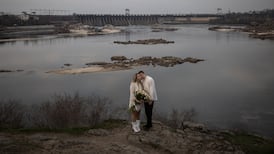The massive operation to right the huge luxury cruise liner the Costa Concordia off the Italian coast began slowly today.
The liner inched slowly off the rock shelf where it has been stuck for more than 20 months, in a painstaking process to right the ship that looked set to continue late into the night.
Photographs of blackened parts of the hull emerging from the seawater show the vessel is turning back to its original aspect, albeit millimetres at a time.
The procedure had got off to a predictably slow start on the island of Giglio this morning, with the rotation of the stricken ship starting almost three hours behind schedule.
A thunderstorm during the night delayed last-minute preparations for today’s complicated operation, which will see the ship move through 65 degrees over a 10-12 hour period as it is lifted from the shallow sea-bed and returned to a vertical position.
It had been hoped to start the salvage at about 6am. Accordingly, the last ferry out of the port of Giglio left at 4.45am to leave the entire area around the ship free of traffic for safety reasons.
Franco Gabrielli, head of Italy's Civil Protection, the authority which is co-ordinating operations, said the salvage had been delayed by three hours because of the overnight storm.
He was quick to add that the delay was relatively insignificant since it had been caused by inclement conditions and not equipment failure.
Despite last night’s storm, weather conditions on a crowded Giglio were good today, with the sun shining and the sea relatively calm.
Engineer Sergio Girotto, a senior member of the international salvage team, told the media that all the equipment was working perfectly, adding: “If you know about maritime operations, then you will know that anything to do with the sea takes time.”
The righting of the 300m-long, 114,000-tonne Concordia represents a voyage into uncharted territory, for two major reasons.
Firstly, the size of a ship that weighs far more than the Titanic did and is 70 metres longer, prompts concern.
Secondly, the ship still lies on the spot where it ran aground on the night of January 13th last year with the loss of 32 lives. The problem is that it lies on two shallow reefs of rock from which it could slide into much deeper water, perhaps to the sea bed.
Much of the salvage operation has been focused on avoiding such a “slide-off”, with the ship currently bound by a myriad series of computer-controlled, hydraulically operated cables which will be used to pull it into a vertical position today.
The “pull” on the Concordia will build up huge pressure in order to move it. All the instruments are computer-directed, and salvage captain Nick Sloan and his team in the floating control barge can monitor everything on and around the ship thanks to a battery of micro-cameras.










